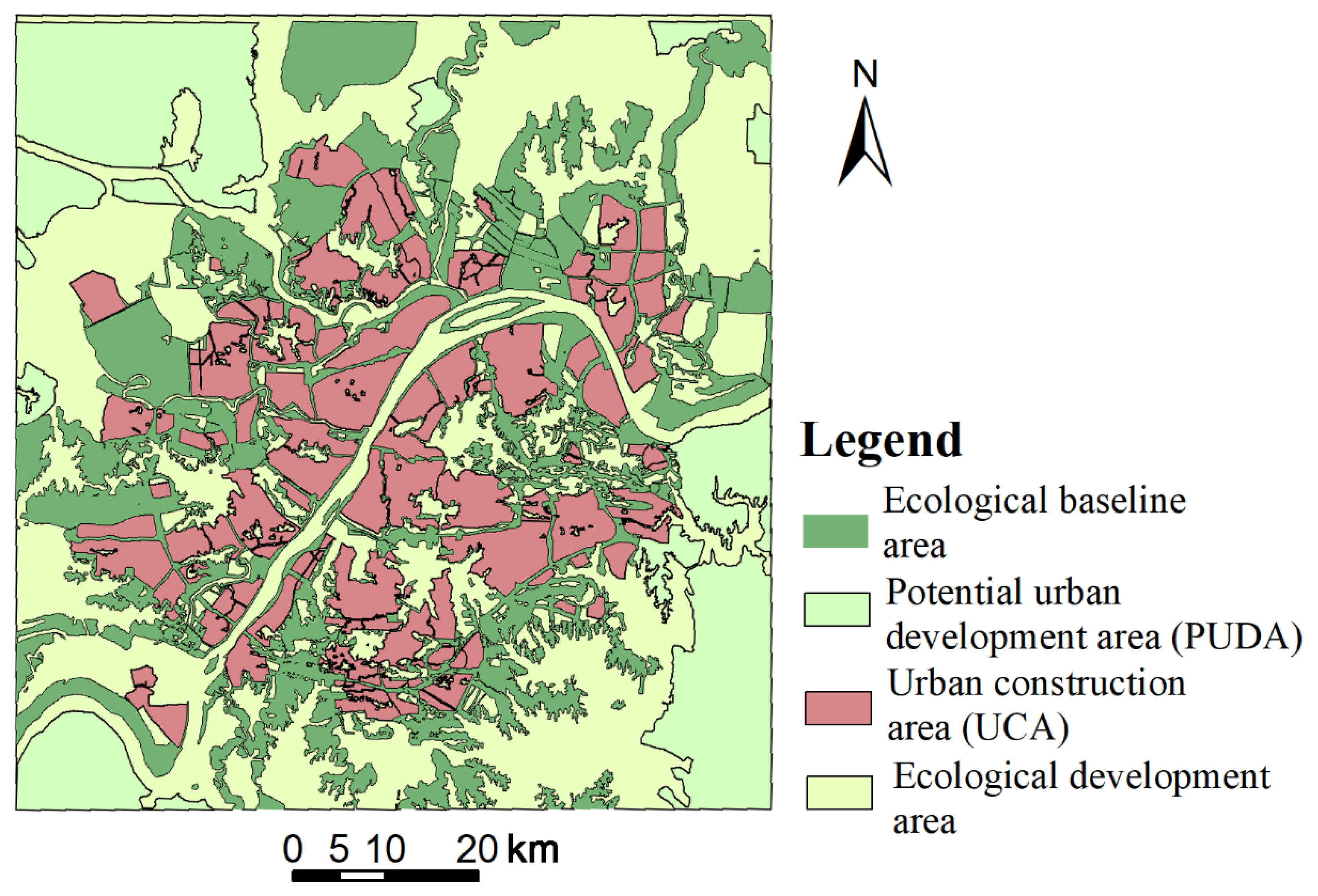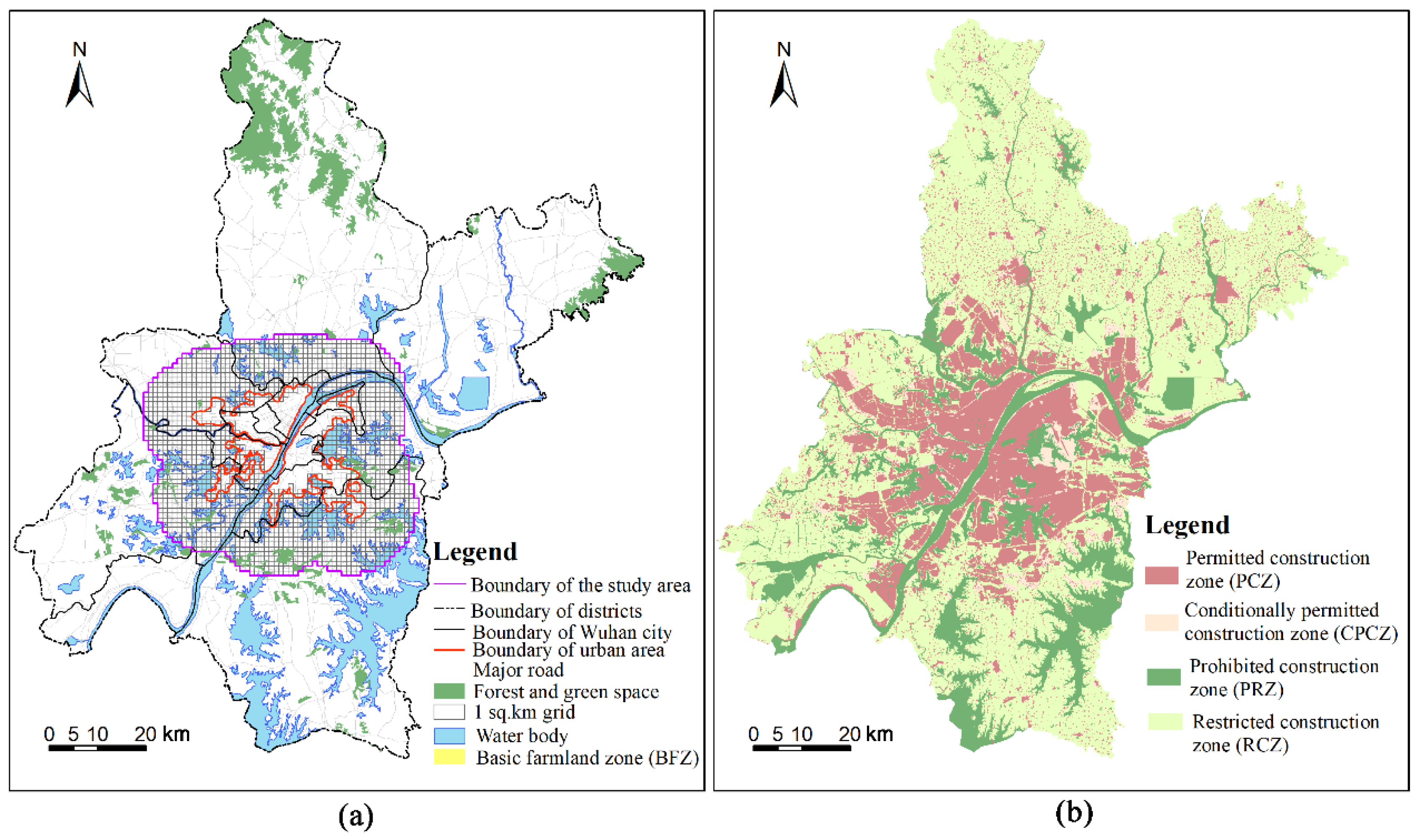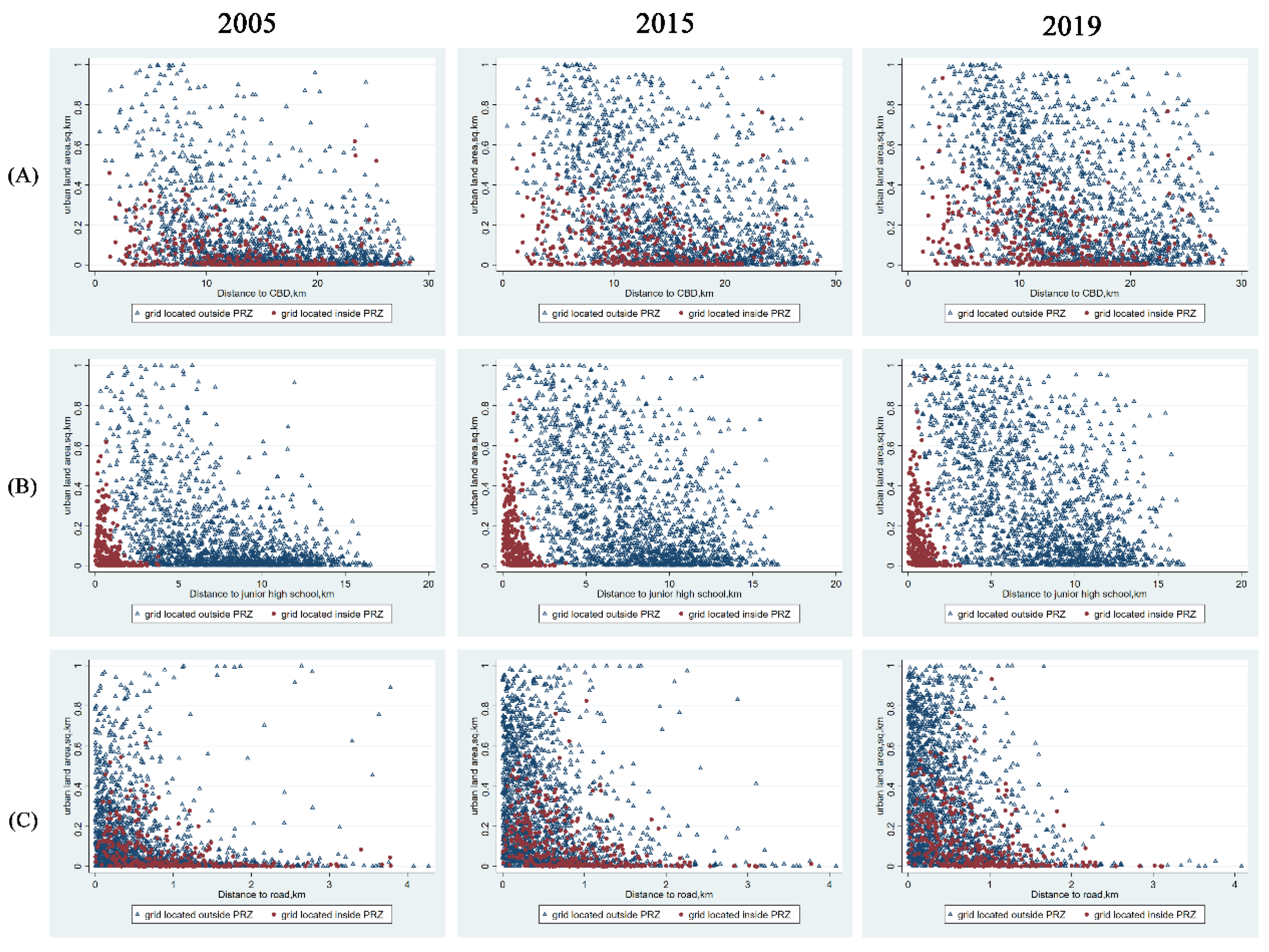More Than Thirty Years of Environmentally Sensitive Area Loss in Wuhan: What Lessons Have We Learned from Urban Containment Policy?
Abstract
:1. Introduction
“Of the 49 articles we reviewed, only three articles discuss policy effectiveness. Similarly, the Chinese literature also lacks policy evaluation research.”(p.30)
2. Local Urban Containment Policies in Wuhan
2.1. Basic Farmland Zoning and Built up Area Zoning Policy in General Land Use Plan
2.2. Ecological Baseline Zoning Policy
3. Empirical Models
3.1. Baseline Model
3.2. Spatial Panel Data Model
3.3. Data and Variables
4. Results
4.1. Spatio-Temporal Change in the Environmentally Sensitive Area in Wuhan
4.2. Regression Results
5. Discussion and Policy Implications
5.1. Why Is There So Much Environmentally Sensitive Area Being Converted to Urban Land?
5.2. Policy Implications for Sustainable Land Use and Environmentally Sensitive Area Protection
6. Conclusions
Author Contributions
Funding
Institutional Review Board Statement
Informed Consent Statement
Data Availability Statement
Conflicts of Interest
References
- Gu, C.; Hu, L.; Cook, I.G. China’s urbanization in 1949–2015: Processes and driving forces. Chin. Geogr. Sci. 2017, 27, 847–859. [Google Scholar] [CrossRef]
- Liu, Y.; Fang, F.; Li, Y. Key issues of land use in China and implications for policy making. Land Use Policy 2014, 40, 6–12. [Google Scholar] [CrossRef]
- Li, Y.; Zhao, S.; Zhao, K.; Xie, P.; Fang, J. Land-cover changes in an urban lake watershed in a mega-city, Central China. Environ. Monit. Assess. 2006, 115, 349–359. [Google Scholar] [CrossRef]
- Mao, D.; Wang, Z.; Wu, J.; Wu, B.; Zeng, Y.; Song, K.; Luo, L. China’s wetlands loss to urban expansion. Land Degrad. Dev. 2018, 29, 2644–2657. [Google Scholar] [CrossRef]
- Wu, Y.; Li, S.; Yu, S. Monitoring urban expansion and its effects on land use and land cover changes in Guangzhou city, China. Environ. Monit. Assess. 2015, 188, 54. [Google Scholar] [CrossRef] [PubMed]
- Xie, C.; Huang, X.; Wang, L.; Fang, X.; Liao, W. Spatiotemporal change patterns of urban lakes in China’s major cities between 1990 and 2015. Int. J. Digit. Earth 2018, 11, 1085–1102. [Google Scholar] [CrossRef]
- Zhou, K.; Liu, Y.; Tan, R.; Song, Y. Urban dynamics, landscape ecological security, and policy implications: A case study from the Wuhan area of central China. Cities 2014, 41, 141–153. [Google Scholar] [CrossRef]
- Jennings, M.D.; Reganold, J.P. Hierarchy and subsidy-stress as a theoretical basis for managing environmentally sensitive areas. Landsc. Urban Plan. 1991, 21, 31–45. [Google Scholar] [CrossRef]
- Ndubisi, F.; DeMeo, T.; Ditto, N.D. Environmentally sensitive areas: A template for developing greenway corridors. Landsc. Urban Plan. 1995, 33, 159–177. [Google Scholar] [CrossRef]
- Gounaridis, D.; Newell, J.P.; Goodspeed, R. The impact of urban sprawl on forest landscapes in Southeast Michigan, 1985–2015. Landsc. Ecol. 2020, 35, 1975–1993. [Google Scholar] [CrossRef]
- Inostroza, L.; Baur, R.; Csaplovics, E. Urban sprawl and fragmentation in Latin America: A dynamic quantification and characterization of spatial patterns. J. Environ. Manag. 2013, 115, 87–97. [Google Scholar] [CrossRef] [PubMed]
- Irwin, E.G.; Bockstael, N.E. The Evolution of Urban Sprawl: Evidence of Spatial Heterogeneity and Increasing Land Fragmentation. Proc. Natl. Acad. Sci. USA 2007, 104, 20672–20677. [Google Scholar] [CrossRef] [PubMed]
- Dupras, J.; Marull, J.; Parcerisas, L.; Coll, F.; Gonzalez, A.; Girard, M.; Tello, E. The impacts of urban sprawl on ecological connectivity in the Montreal Metropolitan Region. Environ. Sci. Policy 2016, 58, 61–73. [Google Scholar] [CrossRef]
- Marulli, J.; Mallarach, J.M. A GIS methodology for assessing ecological connectivity: Application to the Barcelona Metropolitan Area. Landsc. Urban Plan. 2005, 71, 243–262. [Google Scholar] [CrossRef]
- Brueckner, J.K. Urban Sprawl: Diagnosis and Remedies. Int. Reg. Sci. Rev. 2000, 23, 160–171. [Google Scholar] [CrossRef]
- Bateman, I.J.; Harwood, A.R.; Mace, G.M.; Watson, R.T.; Abson, D.J.; Andrews, B.; Termansen, M. Bringing Ecosystem Services into Economic Decision-Making: Land Use in the United Kingdom. Science 2013, 341, 45–50. [Google Scholar] [CrossRef]
- Ewing, R.H. Characteristics, Causes, and Effects of Sprawl: A Literature Review, in Urban Ecology: An International Perspective on the Interaction Between Humans and Nature; Marzluff, J.M., Shulenberger, E., Endlicher, W., Alberti, M., Bradley, G., Ryan, C., Simon, U., ZumBrunnen, C., Eds.; Springer: Boston, MA, USA, 2008; pp. 519–535. [Google Scholar]
- Millward, H. Urban containment strategies: A case-study appraisal of plans and policies in Japanese, British, and Canadian cities. Land Use Policy 2006, 23, 473–485. [Google Scholar] [CrossRef]
- Cho, S.-H.; Chen, Z.; Yen, S.T.; Eastwood, D.B. Estimating Effects of an Urban Growth Boundary on Land Development. J. Agric. Appl. Econ. 2006, 38, 287–298. [Google Scholar] [CrossRef]
- Cho, S.-H.; Omitaomu, O.A.; Poudyal, N.C.; Eastwood, D.B. The Impact of an Urban Growth Boundary on Land Development in Knox County, Tennessee: A Comparison of Two-Stage Probit Least Squares and Multilayer Neural Network Models. J. Agric. Appl. Econ. 2007, 39, 37057. [Google Scholar] [CrossRef]
- Dempsey, J.A.; Plantinga, A.J. How well do urban growth boundaries contain development? Results for Oregon using a difference-in-difference estimator. Reg. Sci. Urban Econ. 2013, 43, 996–1007. [Google Scholar] [CrossRef]
- Jun, M. The Effects of Portland’s Urban Growth Boundary on Urban Development Patterns and Commuting. Urban Stud. 2004, 41, 1333–1348. [Google Scholar] [CrossRef]
- Wassmer, R.W. The Influence of Local Urban Containment Policies and Statewide Growth Management on the Size of United States Urban Areas. J. Reg. Sci. 2006, 46, 25–65. [Google Scholar] [CrossRef]
- Ball, M.; Cigdem, M.; Taylor, E.; Wood, G. Urban Growth Boundaries and their Impact on Land Prices. Environ. Plan. A Econ. Space 2014, 46, 3010–3026. [Google Scholar] [CrossRef]
- Mubarak, F.A. Urban growth boundary policy and residential suburbanization: Riyadh, Saudi Arabia. Habitat Int. 2004, 28, 567–591. [Google Scholar] [CrossRef]
- Gennaio, M.-P.; Hersperger, A.M.; Bürgi, M. Containing urban sprawl—Evaluating effectiveness of urban growth boundaries set by the Swiss Land Use Plan. Land Use Policy 2009, 26, 224–232. [Google Scholar] [CrossRef]
- Ahani, S.; Dadashpoor, H. Urban growth containment policies for the guidance and control of peri-urbanization: A review and proposed framework. Environ. Dev. Sustain. 2021, 23, 14215–14244. [Google Scholar] [CrossRef]
- Bae, C.-H.C.; Jun, M.-J. Counterfactual Planning:What if there had been No Greenbelt in Seoul? J. Plan. Educ. Res. 2003, 22, 374–383. [Google Scholar] [CrossRef]
- Liu, Y.; Zhou, Y. Territory spatial planning and national governance system in China. Land Use Policy 2021, 102, 105288. [Google Scholar] [CrossRef]
- Yang, Y.; Zhang, L.; Ye, Y.; Wang, Z. Curbing Sprawl with Development-limiting Boundaries in Urban China: A Review of Literature. J. Plan. Lit. 2020, 35, 25–40. [Google Scholar] [CrossRef]
- Hepinstall-Cymerman, J.; Coe, S.; Hutyra, L.R. Urban growth patterns and growth management boundaries in the Central Puget Sound, Washington, 1986–2007. Urban Ecosyst. 2013, 16, 109–129. [Google Scholar] [CrossRef]
- Woo, M.; Guldmann, J.-M. Impacts of Urban Containment Policies on the Spatial Structure of US Metropolitan Areas. Urban Stud. 2011, 48, 3511–3536. [Google Scholar] [CrossRef]
- Han, H.-Y.; Lai, S.-K.; Dang, A.-R.; Tan, Z.-B.; Wu, C.-F. Effectiveness of urban construction boundaries in Beijing: An assessment. J. Zhejiang Univ.-Sci. A 2009, 10, 1285–1295. [Google Scholar] [CrossRef]
- Heilig, G.K. Anthropogenic Factors in Land-Use Change in China. Popul. Dev. Rev. 1997, 23, 139–168. [Google Scholar] [CrossRef]
- Kai, X.; Chunfang, K.; Gang, L.; Chonglong, W.; Hongbin, D.; Yi, Z.; Qianlai, Z. Changes of urban wetlands in Wuhan, China, from 1987 to 2005. Prog. Phys. Geogr. Earth Environ. 2010, 34, 207–220. [Google Scholar] [CrossRef]
- Ministry of Natural Resources of the People’s Republic of China. A Review of the 30-Year History of Land Use Planning in China. 2009. Available online: https://www.mnr.gov.cn/dt/ywbb/201810/t20181030_2246134.html (accessed on 10 January 2022).
- Bockstael, N.E. Modeling Economics and Ecology: The Importance of a Spatial Perspective. Am. J. Agric. Econ. 1996, 78, 1168–1180. [Google Scholar] [CrossRef]
- Alonso, W. Location and land use. In Toward a General Theory of Land Rent; Harvard University Press: Cambridge, MA, USA, 1964. [Google Scholar]
- Colsaet, A.; Laurans, Y.; Levrel, H. What drives land take and urban land expansion? A systematic review. Land Use Policy 2018, 79, 339–349. [Google Scholar] [CrossRef]
- Irwin, E.G.; Bockstael, N.E. Interacting agents, spatial externalities and the evolution of residential land use patterns. J. Econ. Geogr. 2002, 2, 31–54. [Google Scholar] [CrossRef]
- Irwin, E.G.; Bockstael, N.E. Land use externalities, open space preservation, and urban sprawl. Reg. Sci. Urban Econ. 2004, 34, 705–725. [Google Scholar] [CrossRef]
- Serneels, S.; Lambin, E.F. Proximate causes of land-use change in Narok District, Kenya: A spatial statistical model. Agric. Ecosyst. Environ. 2001, 85, 65–81. [Google Scholar] [CrossRef]
- Elhorst, J.P. Spatial Econometrics: From Cross-Sectional Data to Spatial Panels; Springer: Berlin/Heidelberg, Germany, 2014. [Google Scholar]
- LeSage, J.P.; Pace, R.K. Introduction to Spatial Econometrics; CRC Press: Boca Raton, FL, USA, 2009. [Google Scholar]
- Wuhan Municipal Statistics Bureau. Wuhan Statistical Yearbook (2020, 2021); China Statistics Press: Beijing, China, 2021. [Google Scholar]
- Yang, J.; Huang, X. The 30 m annual land cover dataset and its dynamics in China from 1990 to 2019. Earth Syst. Sci. Data 2021, 13, 3907–3925. [Google Scholar] [CrossRef]
- Chan, J.; Fang, X.; Wang, Z.; Zai, X.; Zhang, Q. Valuing primary schools in urban China. J. Urban Econ. 2020, 115, 103183. [Google Scholar] [CrossRef]
- Wen, H.; Zhang, Y.; Zhang, L. Do educational facilities affect housing price? An empirical study in Hangzhou, China. Habitat Int. 2014, 42, 155–163. [Google Scholar] [CrossRef]
- Meng, M.; Shang, Y.; Yang, Y. Did highways cause the urban polycentric spatial structure in the Shanghai metropolitan area? J. Transp. Geogr. 2021, 92, 103022. [Google Scholar] [CrossRef]
- Müller, K.; Steinmeier, C.; Küchler, M. Urban growth along motorways in Switzerland. Landsc. Urban Plan. 2010, 98, 3–12. [Google Scholar] [CrossRef]
- Reilly, M.K.; O’Mara, M.P.; Seto, K.C. From Bangalore to the Bay Area: Comparing transportation and activity accessibility as drivers of urban growth. Landsc. Urban Plan. 2009, 92, 24–33. [Google Scholar] [CrossRef]
- Du, N.; Ottens, H.; Sliuzas, R. Spatial impact of urban expansion on surface water bodies—A case study of Wuhan, China. Landsc. Urban Plan. 2010, 94, 175–185. [Google Scholar] [CrossRef]
- Zheng, H.W.; Shen, G.Q.; Wang, H. A review of recent studies on sustainable urban renewal. Habitat Int. 2014, 41, 272–279. [Google Scholar] [CrossRef]
- Peterseil, J.; Wrbka, T.; Plutzar, C.; Schmitzberger, I.; Kiss, A.; Szerencsits, E.; Beissmann, H. Evaluating the ecological sustainability of Austrian agricultural landscapes—The SINUS approach. Land Use Policy 2004, 21, 307–320. [Google Scholar] [CrossRef]
- Moser, D.; Zechmeister, H.G.; Plutzar, C.; Sauberer, N.; Wrbka, T.; Grabherr, G. Landscape patch shape complexity as an effective measure for plant species richness in rural landscapes. Landsc. Ecol. 2002, 17, 657–669. [Google Scholar] [CrossRef]
- Diao, M.; Leonard, D.; Sing, T.F. Spatial-difference-in-differences models for impact of new mass rapid transit line on private housing values. Reg. Sci. Urban Econ. 2017, 67, 64–77. [Google Scholar] [CrossRef]
- Tan, R.; He, Q.; Zhou, K.; Xie, P. The effect of new metro stations on local land use and housing prices: The case of Wuhan, China. J. Transp. Geogr. 2019, 79, 102488. [Google Scholar] [CrossRef]
- Wang, F. Measurement, Optimization, and Impact of Health Care Accessibility: A Methodological Review. Ann. Assoc. Am. Geogr. 2012, 102, 1104–1112. [Google Scholar] [CrossRef] [PubMed]






| VarName | Obs | Mean | SD | Min | Max |
|---|---|---|---|---|---|
| Urban_area | 10,175 | 0.151 | 0.231 | 0.000 | 1.000 |
| Log(Distance to CBD) | 10,175 | 9.463 | 0.528 | 5.979 | 10.260 |
| Log(Distance to highway) | 10,175 | 7.567 | 0.806 | 2.756 | 9.054 |
| Log(Distance to junior high school) | 10,175 | 8.775 | 0.616 | 4.900 | 9.750 |
| Slope | 10,175 | 0.282 | 0.291 | 0.021 | 2.787 |
| Distance to national industrial park | 10,175 | 5120.458 | 5625.152 | 0.000 | 23,836.600 |
| Distance to provincial industrial park | 10,175 | 6600.145 | 4479.517 | 0.000 | 19,447.500 |
| Distance to lake | 10,175 | 1888.821 | 2106.037 | 0.000 | 10,880.400 |
| Distance to river | 10,175 | 7671.116 | 6078.567 | 0.000 | 27,389.801 |
| Log(Distance to road) | 10,175 | 6.301 | 1.356 | −3.961 | 9.142 |
| Log(GDP) | 10,175 | 7.396 | 1.925 | 4.428 | 9.611 |
| Log(NAP) | 10,175 | 15.393 | 0.200 | 15.160 | 15.683 |
| Log(TIN) | 10,175 | 6.561 | 2.203 | 3.048 | 9.104 |
| Log(DIPM) | 10,175 | 6.645 | 1.407 | 4.390 | 8.281 |
| BFZ | 10,175 | 0.073 | 0.260 | 0.000 | 1.000 |
| PCZ | 10,175 | 0.265 | 0.442 | 0.000 | 1.000 |
| CPCZ | 10,175 | 0.040 | 0.196 | 0.000 | 1.000 |
| RCZ | 10,175 | 0.181 | 0.385 | 0.000 | 1.000 |
| PRZ | 10,175 | 0.114 | 0.317 | 0.000 | 1.000 |
| EBA | 10,175 | 0.118 | 0.323 | 0.000 | 1.000 |
| EDA | 10,175 | 0.138 | 0.345 | 0.000 | 1.000 |
| Cropland | Forest | Grassland | Water | Barren | Built-Up Area | |
|---|---|---|---|---|---|---|
| Cropland | 963.24 | 9.85 | 0.42 | 46.40 | 0.26 | 466.20 |
| Forest | 15.54 | 43.84 | 0.13 | 0.27 | 0.00 | 4.62 |
| Grassland | 0.19 | 0.06 | 0.00 | 0.02 | 0.00 | 0.46 |
| Water | 74.47 | 0.07 | 0.01 | 292.93 | 0.02 | 39.36 |
| Barren | 0.00 | 0.00 | 0.00 | 0.00 | 0.00 | 0.02 |
| Built-up area | 1.49 | 0.01 | 0.00 | 0.67 | 0.00 | 74.44 |
| General Land Use Plan | Ecological Baseline | |||||
|---|---|---|---|---|---|---|
| (1) Pooled OLS | (2) FE | (3) SPDM | (4) Pooled OLS | (5) FE | (6) SPDM | |
| Log(Distance to CBD) | −0.0642 *** | −0.0684 *** | ||||
| (0.00893) | (0.00909) | |||||
| Log(Distance to highway) | −0.0178 *** | −0.0228 *** | ||||
| (0.00397) | (0.00398) | |||||
| Log(Distance to junior high school) | −0.0512 *** | −0.0519 *** | ||||
| (0.00834) | (0.00870) | |||||
| Slope | 0.00875 | 0.00845 | ||||
| (0.00834) | (0.00829) | |||||
| Distance to national industrial park | −0.00000115 ** | −0.00000165 *** | ||||
| (0.000000522) | (0.000000521) | |||||
| Distance to provincial industrial park | −0.00000515 *** | −0.00000583 *** | ||||
| (0.000000918) | (0.000000909) | |||||
| Distance to lake | 0.00000562 *** | 0.00000989 *** | ||||
| (0.00000170) | (0.00000173) | |||||
| Distance to river | −0.00000360 *** | −0.00000349 *** | ||||
| (0.000000454) | (0.000000454) | |||||
| Log(Distance to road) | −0.0204 *** | −0.00723 *** | −0.00499 *** | −0.0253 *** | −0.00494 * | −0.00344 *** |
| (0.00236) | (0.00256) | (0.00134) | (0.00243) | (0.00278) | (0.00133) | |
| Log(GDP) | 0.175 *** | 0.0342 *** | −3.63 × 10−14 | −0.0539 *** | 0.364 *** | 1.87 × 10−11 |
| (0.00751) | (0.00741) | (5.171) | (0.00607) | (0.0139) | (5.267) | |
| Log(NAP) | 0.325 *** | 0.438 *** | −6.15 × 10−13 | 0.670 *** | 0.579 *** | 2.16 × 10−10 |
| (0.0111) | (0.0141) | (15.92) | (0.0162) | (0.0159) | (17.40) | |
| Log(TIN) | −0.132 *** | −0.307 *** | 0.261 | −0.503 *** | 0.172 | |
| (0.00597) | (0.0118) | (5.495) | (0.0177) | (5.835) | ||
| Log(DIPM) | 0.409 *** | −0.552 | 0.0794 *** | 0.317 *** | −0.351 | |
| (0.0187) | (8.923) | (0.00663) | (0.0130) | (10.23) | ||
| BFZ | −0.00865 | −0.0362 *** | −0.000549 | |||
| (0.00798) | (0.00769) | (0.00702) | ||||
| PCZ | 0.0657 *** | 0.205 *** | 0.201 *** | |||
| (0.00666) | (0.00804) | (0.00546) | ||||
| CPCZ | −0.0795 *** | 0.0950 *** | 0.0908 *** | |||
| (0.0130) | (0.0139) | (0.00898) | ||||
| RCZ | −0.128 *** | 0.0222 *** | 0.0696 *** | |||
| (0.00676) | (0.00740) | (0.00639) | ||||
| PRZ | −0.174 *** | |||||
| (0.00723) | ||||||
| EBA | −0.166 *** | −0.200 *** | −0.139 *** | |||
| (0.00952) | (0.0100) | (0.00504) | ||||
| EDA | −0.206 *** | −0.219 *** | −0.190 *** | |||
| (0.00937) | (0.00977) | (0.00475) | ||||
| _cons | −3.875 *** | −7.574 *** | 0.0982 *** | −8.754 *** | −10.18 *** | 0.0978 *** |
| (0.195) | (0.243) | (0.000770) | (0.268) | (0.283) | (0.000766) | |
| W*Urban_area | 2.748 *** | 2.646 *** | ||||
| (0.0507) | (0.0495) | |||||
| Year dummies | Yes | Yes | Yes | Yes | Yes | Yes |
| Number of observations | 10,175 | 10,175 | 10,175 | 10,175 | 10,175 | 10,175 |
| R2 | 0.501 | 0.552 | 0.455 | 0.562 | ||
| adj. R2 | 0.500 | 0.552 | 0.455 | 0.561 | ||
| AIC | −7950.5 | −17,957.2 | −14,618.4 | −7062.6 | −18,176.5 | −14,701.0 |
| pseudo-R2 | 0.144 | 0.146 | ||||
Publisher’s Note: MDPI stays neutral with regard to jurisdictional claims in published maps and institutional affiliations. |
© 2022 by the authors. Licensee MDPI, Basel, Switzerland. This article is an open access article distributed under the terms and conditions of the Creative Commons Attribution (CC BY) license (https://creativecommons.org/licenses/by/4.0/).
Share and Cite
Zhou, K.; Tan, R. More Than Thirty Years of Environmentally Sensitive Area Loss in Wuhan: What Lessons Have We Learned from Urban Containment Policy? Land 2022, 11, 1310. https://doi.org/10.3390/land11081310
Zhou K, Tan R. More Than Thirty Years of Environmentally Sensitive Area Loss in Wuhan: What Lessons Have We Learned from Urban Containment Policy? Land. 2022; 11(8):1310. https://doi.org/10.3390/land11081310
Chicago/Turabian StyleZhou, Kehao, and Ronghui Tan. 2022. "More Than Thirty Years of Environmentally Sensitive Area Loss in Wuhan: What Lessons Have We Learned from Urban Containment Policy?" Land 11, no. 8: 1310. https://doi.org/10.3390/land11081310





